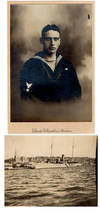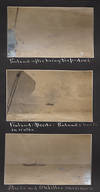by Compiled by Quartermaster 3rd Class Charles Chambron
"Taking survivors aboard. . .."
This large album measures 12" x 9.5" and contains well over 250 glued-in photographs, most measuring about 4" x 2.5". The photographs are captioned in white ink on 46 of the album's 48 pages. Ten additional photographs are laid-in including a 10" x 8" official group photograph of the crew (with a two-inch closed tear) and two smaller portrait photos of Chambron in uniform (one is full length). Everything is in nice shape.
The well-composed photos picture all members of the ship (quarterdeck, bow, guns, lifeboats, etc.), the ship's crew (many identified), dirigibles, other U.S. Navy vessels, dirigibles, airplanes, (truncated)
This large album measures 12" x 9.5" and contains well over 250 glued-in photographs, most measuring about 4" x 2.5". The photographs are captioned in white ink on 46 of the album's 48 pages. Ten additional photographs are laid-in including a 10" x 8" official group photograph of the crew (with a two-inch closed tear) and two smaller portrait photos of Chambron in uniform (one is full length). Everything is in nice shape.
The well-composed photos picture all members of the ship (quarterdeck, bow, guns, lifeboats, etc.), the ship's crew (many identified), dirigibles, other U.S. Navy vessels, dirigibles, airplanes, (truncated)














